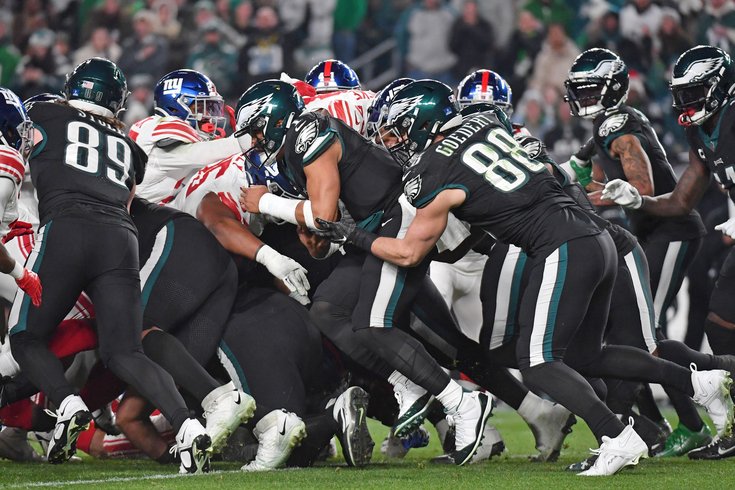
January 15, 2024
 Eric Hartline/USA TODAY Sports
Eric Hartline/USA TODAY Sports
Jalen Hurts gets a first down on a tush push against the New York Giants on Christmas.
The Eagles' tried-and-true Tush Push has been downright dominant in short yardage situations. Defenses don't have an answer for it and other offenses can't seem to replicate its success. Why is the play so effective?
Heading into Monday night's playoff game against the Buccaneers, NFL Network's Kyle Brandt paid a visit to renowned physicist Neil deGrasse Tyson to ask him about the mechanics of the Tush Push, also known as the Brotherly Shove.
The answer deGrasse Tyson gave is pretty simple: The Eagles have an advantage because they're moving first and using the Earth to propel them forward. Reacting defenders often launch themselves in the air, losing leverage that might counteract the Eagles' front.
Is time travel possible?
— Kyle Brandt (@KyleBrandt) January 14, 2024
Are we alone in the universe?
How do you stop the Eagles’ Tush Push?
I asked Dr. Neil deGrasse Tyson one of these questions. @neiltyson pic.twitter.com/tVUzp1zXII
"The Eagles get, like, a quarter-second head start in momentum transfer, OK?" de Grasse Tyson said. "So the Eagles are already in motion. They are using Earth as a launch point for their movement. In fact, if you run the math on this, every time the Eagles run this play, it slightly changes the rotation of the Earth."
At various points this season, defenders have tried leaping over the advancing Eagles offensive line to stop Jalen Hurts. The offensive line drives low on the play, clearing the path for Hurts to charge forward before leaping tacklers can stop the momentum in front of him.
"If you're not connected to the Earth, you've got nothing to press against," deGrasse Tyson said.
Jalen Hurts set an NFL record with 15 quarterback rushing touchdowns this season. On nearly every TV broadcast, the announcers attribute the play's success, in part, to Hurts' legendary ability to squat 600 pounds. DeGrasse Tyson disagrees with that assessment.
"It is irrelevant in this play because he's airborne," he said.
That likely depends on the particular play, since Hurts can often be seen churning his legs as his teammates push him from behind. The basic point deGrasse Tyson makes is that the offensive line's use of the ground adds the mass of the Earth into the equation in the Eagles' favor. In terms of sheer force, that plays a much bigger role than Hurts' strength or the added pushes he gets from the players behind him.
Eagles offensive line coach Jeff Stoutland refined the Tush Push by seeking advice from Scottish rugby coach Richie Gray, who visited the Eagles to help on both sides of the ball. Stoutland wanted feedback on the Tush Push and how defenses might attack it. On his "New Heights" podcast, center Jason Kelce summarized Gray's reaction to the play in his best Scottish accent.
"He says, 'Coach, there is nothing you can do to stop it, it's organized mass!'" Kelce said.
Apart from most non-Eagles fans hating the Tush Push, there's been consistent chatter about the NFL's competition committee potentially banning the play this offseason. The play survived last year's owners meetings, but it's likely to face another round of scrutiny this spring with more data on its use and any injuries that may be attributed to it.
One common technical criticism of the Tush Push is that some people feel it works too much like a rugby play to be allowed in the NFL. Sportswriter Peter King called it an "abomination" and said the NFL made a mistake not getting rid of it this season.
Eagles left tackle Jordan Mailata, who formerly played rugby in Australia, strongly disagreed with that notion when he joined the Kelce brothers on their podcast earlier this season. He said he doesn't use any rugby techniques for the Tush Push.
"It's got nothing to do with any rugby movements," Mailata said. "It's not a rugby play."
But in December, University of California rugby coach Jack Clark said the Tush Push presents defensive problems that are apparent in certain aspects of both rugby and football. He suggested the best approach to stopping it in either sport is to mirror the movement of the push instead of playing a man-to-man technique.
"The answer is probably unfulfilling to some, but you just mirror that activity," Clark told San Francisco's SFGate. "Whether it’s over the center, or over the guard, you stack into those places and you try to layer your defenses well and you just mimic them. You don’t try to tackle the ball carrier. You just try to go forward and create that space for the guys behind you to go make that tackle."
As for the possibility of the NFL eliminating the Tush Push, Mailata said the complaints about it are understandable — but he also wonders why other teams don't spend time perfecting it.
"If we were getting destroyed like that, I would understand. But I don't know why. More people just need to run it," Mailata said.
And despite King's opposition to the play, he said he doesn't think defenses have tried hard enough to strategize against it.
"I think too many teams just say, 'Well, the Eagles are on the half-yard line. We're not going to get our guys hurt. Have the touchdown,'" King said.
Last month, NFL commissioner Roger Goodell denied reports that he wants the play banned, saying he hasn't taken a position on what to do about the Tush Push next season.
"Last year the committee had a lot of different views on that, the membership did," Goodell said. "I want to hear that again this year. I want to hear how people feel about it."
The NFL's executive vice president of football operations, Troy Vincent, a former Eagle, said he's not sure there's a valid reason to eliminate the play.
"Philly does it better than everyone else. That’s a fact," Vincent said. "You won’t want to punish anyone for doing something well. People have tried different things to stop it, have not had success."
As the Eagles take on the Bucs after a disastrous 1-5 end to the regular season, the Tush Push may be the offense's most consistent play. No one knows how the Eagles will perform in Tampa, but it's probably a solid bet they'll rely on the Tush Push to move the chains and cross the goal line, at some point. If the team looks anything like it has lately, it may be one of the few plays that keeps them competitive enough to survive with a win. .